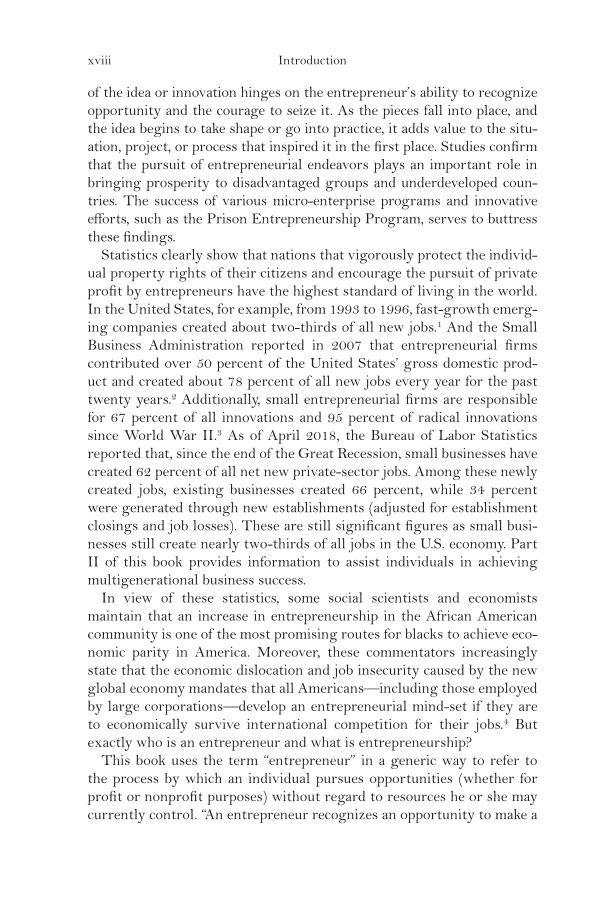xviii Introduction of the idea or innovation hinges on the entrepreneur’s ability to recognize opportunity and the courage to seize it. As the pieces fall into place, and the idea begins to take shape or go into practice, it adds value to the situ- ation, project, or process that inspired it in the first place. Studies confirm that the pursuit of entrepreneurial endeavors plays an important role in bringing prosperity to disadvantaged groups and underdeveloped coun- tries. The success of various micro-enterprise programs and innovative efforts, such as the Prison Entrepreneurship Program, serves to buttress these findings. Statistics clearly show that nations that vigorously protect the individ- ual property rights of their citizens and encourage the pursuit of private profit by entrepreneurs have the highest standard of living in the world. In the United States, for example, from 1993 to 1996, fast-growth emerg- ing companies created about two-thirds of all new jobs.1 And the Small Business Administration reported in 2007 that entrepreneurial firms contributed over 50 percent of the United States’ gross domestic prod- uct and created about 78 percent of all new jobs every year for the past twenty years.2 Additionally, small entrepreneurial firms are responsible for 67 percent of all innovations and 95 percent of radical innovations since World War II.3 As of April 2018, the Bureau of Labor Statistics reported that, since the end of the Great Recession, small businesses have created 62 percent of all net new private-sector jobs. Among these newly created jobs, existing businesses created 66 percent, while 34 percent were generated through new establishments (adjusted for establishment closings and job losses). These are still significant figures as small busi- nesses still create nearly two-thirds of all jobs in the U.S. economy. Part II of this book provides information to assist individuals in achieving multigenerational business success. In view of these statistics, some social scientists and economists maintain that an increase in entrepreneurship in the African American community is one of the most promising routes for blacks to achieve eco- nomic parity in America. Moreover, these commentators increasingly state that the economic dislocation and job insecurity caused by the new global economy mandates that all Americans—including those employed by large corporations—develop an entrepreneurial mind-set if they are to economically survive international competition for their jobs.4 But exactly who is an entrepreneur and what is entrepreneurship? This book uses the term “entrepreneur” in a generic way to refer to the process by which an individual pursues opportunities (whether for profit or nonprofit purposes) without regard to resources he or she may currently control. “An entrepreneur recognizes an opportunity to make a
Document Details My Account Print multiple pages
Print
You have printed 0 times in the last 24 hours.
Your print count will reset on at .
You may print 0 more time(s) before then.
You may print a maximum of 0 pages at a time.


















































































































































































































































































































































































































































